 |
Catalogs
Cepheid Phys. Properties
Binary Cepheid Solutions
Projects
SB2 Cepheids
Classical Cepheids
Type II Cepheids
Papers
by category
by first author
by target
Visitors so far: 87808.
The presence of type II Cepheids in eclipsing binaries give us the same opportunity for studying the physics and evolution of these stars in unprecedented detail. Although not as famous as classical Cepheids, type II Cepheids are also being used as distance indicators, and sometimes are indispensable, as classical Cepheids (being young stars) are not present in all types of galaxies and stellar systems. Their evolution is also more mysterious and our understanding of their origin, structure and pulsations is more limited. The results for the first candidate for such a system were published in 2017, but it appeared that it may be a slightly different object with the mass somewhere in between that of classical and type II Cepheids. The first system containg a genuine type II Cepheid was eventually analyzed and published in 2018. I'm leading this project from the beginning, when it started in 2015.
One of the most important results is the first-ever measurement of a dynamical mass of a type II Cepheid. Before only estimates from pulsation and evolution theories were available, with the most probable masses around 0.5-0.6 M⊙ (and below 1 M⊙ in general). Dynamical masses come from the analysis of orbital motion in binary systems through Kepler laws. This is the most accurate way of determining masses of stars known. We have analyzed carefully two candidates for type II Cepheids in eclipsing binary systems, but one of them turned out not to fit to any class of known pulsators, being located somewhere in between classical and type-II Cepheids. The other (OGLE-LMC-T2CEP-211) resulted to be a genuine type II Cepheid of peculiar W Virginis type. The mass of this Cepheid was measured to be M=0.64 +/- 0.02 M⊙, quite close to, but somewhat larger than the expected values.
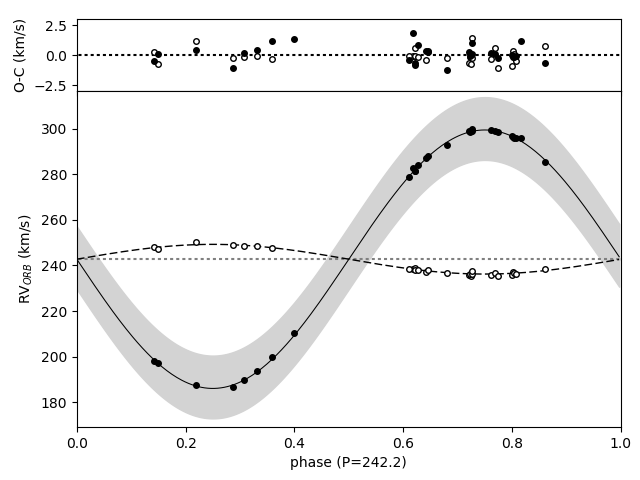
During the analysis of one candidate for a type-II Cepheid, OGLE-LMC-T2CEP-098) in eclipsing binary we found that some of its parameters are not consistent with what we expected for type II Cepheids. For example its brightness after the subtracion of the light of its companion (as seen in the plot below) place it almost exactly in between the classical and type-II Cepheids. The mass that we determined, M= 1.51 ± 0.09 M⊙, is also too high for type II Cepheids and too low for classical Cepheids (starting from about 3.5 M⊙). All of these characteristics point to either a variable of a new class or an Anomalous Cepheid of an exceptionally long (never found before) period. The period of this Cepheid is about 5 days, while the Anomalous Cepheids have period no longer than about 2.5 days (see plot below).
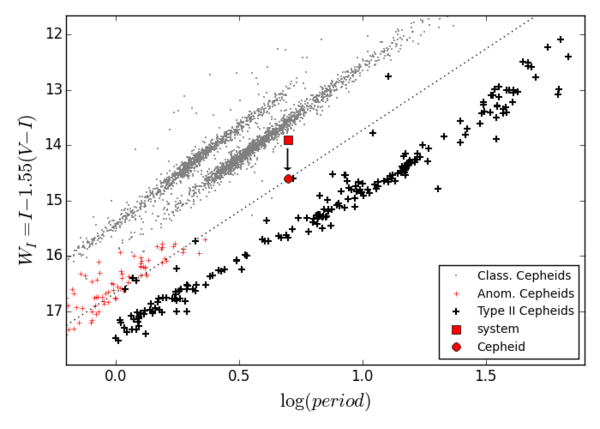
During the study of OGLE-LMC-T2CEP-211 we found that its current configuration and very high mass ratio (about 9) cannot be explained without taking into account a binary interaction in the past. The most probable scenario was that the current Cepheid was at first the more massive component and evolved out of the main-sequence, increased its size reaching the critical radius of the so-called Roche lobe and started to transfer the mass on the companion. Eventually the mass ratio has reversed and the Cepheid was left with its Helium-rich nucleus, while the companion ended up as a massive compact star surrounded by a disk. This scenario was later confirmed by detailed binary evolution modeling, which gave us also the most probable initial parameters of the binary system, 200 million years ago, when the system was formed (see the animation below). Similar scenario is expected for OGLE-LMC-T2CEP-098, where also high mass ratio was found, although no detailed binary-evolution modeling was performed.
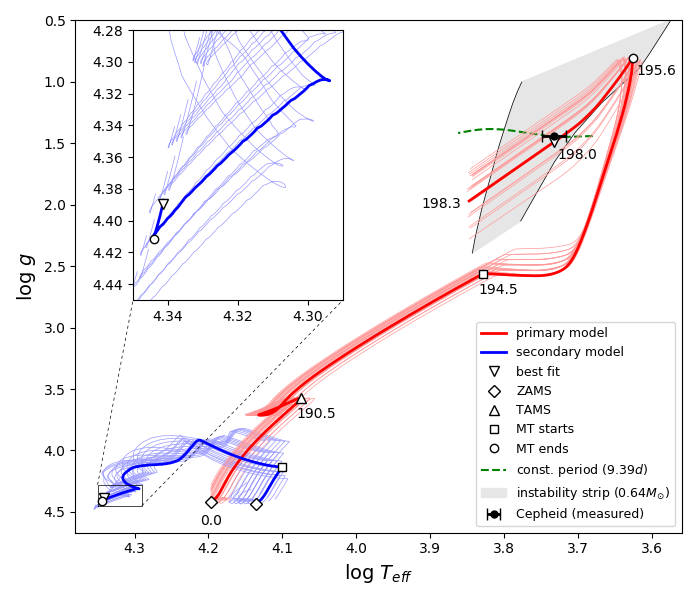
Click the figure to see it animated.
We found that hydrogen deficient atmoshere can explain the shape of the radial velocity curves of peculiar W Vir stars. The binary evolution model of OGLE-LMC-T2CEP-211 confirmed that Cepheid in this system is now composed mostly of helium (~92%), with a very low surface abundance of hydrogen (~42%). We calculated model radial velocity curves for two different atmoshpere abundance of hydrogen (see plots below) and found that the observations cannot be explained assuming a typical abundance, while for our predicted value of hydrogen abundance the model fits the data very well.
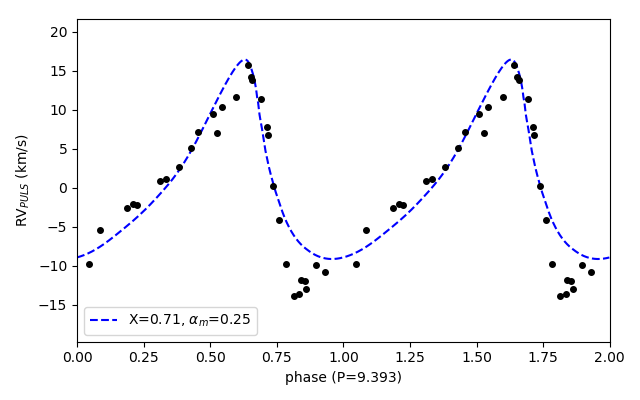
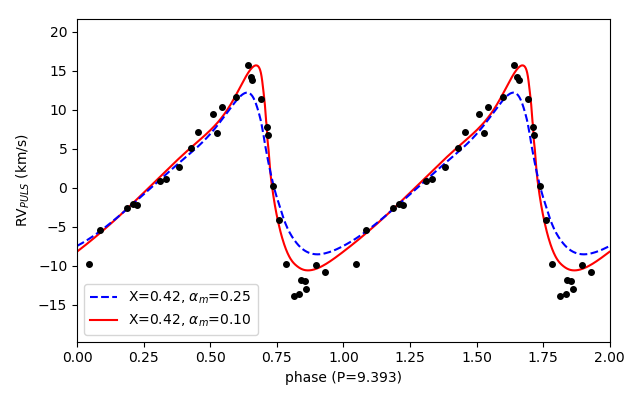
In the analysis of the binary system with the Cepheid OGLE-LMC-T2CEP-098 we could not measure radial velocities of the companion. Normally in such a situation only lower limit can be placed for the mass of the companion and nothing can be said about the primary (the Cepheid in our case). However we developed a method for obtaining precise physical parameters of both components by exploiting the maximum information from the analysis of light and radial velocity curves (and in particular the correlation between the mass and radius) and adding an additional constraint from the modeling based on pulsation theory -- the solution is only accepted if the observed period matches the theoretical period for given physical parameters. The same method was later checked for systems with for which the accurate parameters can be determined independently. A similar method was also used for the system where the disk presence impeded a precise determination of the radii.
The study of type II Cepheids in eclipsing binary systems confirmed a common presence of a disk around the companions to the Cepheids. As the Cepheids are well within their corresponding Roche lobes, there is no mass transfer apart from the fraction of the matter from the stellar wind. As the companions are in general blue and massive, the most probable explanation is that they are rapidly rotating Be stars with a decretion disk around. For OGLE-LMC-T2CEP-211 this scenario was confirmed by the binary evolution study. Thus, the peculiar W Virgins and Be stars are probably products of the same evolutionary channel.
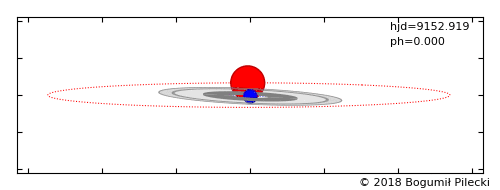
From the preliminary study of other candidates for type-II Cepheids in eclipsing binary systems we found that most of them are similar to OGLE-LMC-T2CEP-211 both regarding its mass, evolution and current system configuration, i.e. a presence of a disk around a companion. However because of additional complications like a presence of a third body and fast period change more data is necessary to finish the analysis of these systems.
| The dynamical mass and evolutionary status of the type-II Cepheid in the eclipsing binary system OGLE-LMC-T2CEP-211 with a double-ring disk |
|---|
| Bogumił Pilecki, A. Dervisoglu, W. Gieren, R. Smolec, I. Soszyński, G. Pietrzyński, I. B. Thompson, M. Taormina |
| 2018, ApJ, 868, 30 - More information - Get data |
| The Araucaria Project: High-precision Cepheid astrophysics from the analysis of variables in double-lined eclipsing binaries |
| Bogumił Pilecki, W. Gieren, G. Pietrzyński, I. B. Thompson, R. Smolec, D. Graczyk, M. Taormina, A. Udalski, J. Storm, N. Nardetto, A. Gallenne, P. Kervella, I. Soszyński, M. Górski, P. Wielgórski, K. Suchomska, P. Karczmarek, B. Zgirski |
| 2018, ApJ, 862, 43 - More information - Get data |
| Mass and p-factor of the type II Cepheid OGLE-LMC-T2CEP-098 in a binary system |
| Bogumił Pilecki, W. Gieren, R. Smolec, G. Pietrzyński, I. B. Thompson, R. I. Anderson, G. Bono, I. Soszyński, P. Kervella, N. Nardetto, M. Taormina, K. Stępień, P. Wielgórski |
| 2017, ApJ, 842, 110 - More information - Get data |
| Physical properties and evolutionary status of Cepheids in eclipsing binaries in the LMC |
|---|
| Bogumił Pilecki |
| 2019, Zenodo, 4984145 |
| The Impact of Eclipsing Binaries with Pulsating Components on the Distance Scale and Stellar Evolution |
| Bogumił Pilecki |
| 2018, ASPC, 514, 123P |
| Cepheids in Eclipsing Binaries. What and How We Can Learn About Them |
| Bogumił Pilecki |
| 2018, Proceedings of the PAS, 6, 237 |
| Pulsation Theory Models for Cepheids in Eclipsing Binary Systems |
| Mónica Taormina, Bogumił Pilecki,Radosław Smolec |
| 2018, Proceedings of the PAS, 6, 325 |
| Araucaria Project: Pulsating stars in binary systems and as distance indicators |
| Bogumił Pilecki, W. Gieren, G. Pietrzyński, R. Smolec |
| 2017, EPJWC, 152, 7007 |
| Candidates for non-pulsating stars located in the Cepheid instability strip in the Large Magellanic Cloud based on Strömgren photometry |
|---|
| Narloch W., Pietrzyński G., Kołaczkowski Z., Smolec R., Górski M., Kubiak M., Udalski A., Soszyński I., Graczyk D., Gieren W., Karczmarek P., Zgirski B., Wielgórski P., Suchomska K., Pilecki B., Taormina M., Kałuszyński M. |
| 2019, MNRAS, 489, 3285 |
| A Geometrical 1\% Distance to the Short-period Binary Cepheid V1334 Cygni |
| Gallenne, A., Kervella, P., Evans, N.~R., Proffitt, C.~R., Monnier, J.~D., Merand, A., Nelan, E., Winston, E., Pietrzyński, G., Schaefer, G., Gieren, W., Anderson, R.~I., Borgniet, S., Kraus, S., Roettenbacher, R.~M., Baron, F., Pilecki, B., Taormina, M.,... |
| 2018, ApJ, 867, 121 |
| CRIRES high-resolution infrared spectroscopy of the long-period Cepheid l Carinae |
| Nardetto, N.; Poretti, E.; Gallenne, A.; Rainer, M.; Anderson, R. I.; Fouqué, P.; Gieren, W.; Graczyk, D.; Kervella, P.; Mathias, P.; Mérand, A.; Mourard, D.; Neilson, H.; Pietrzynski, G.; Pilecki, B.; Storm, J.; Borgniet, S.; Chiavassa, A.; Hocdé, V.; ... |
| 2018, A&A, 616, 92 |
| The Araucaria Project: A study of the classical Cepheid in the eclipsing binary system OGLE LMC562.05.9009 in the Large Magellanic Cloud |
| W. Gieren, B. Pilecki, G. Pietrzynski, D. Graczyk, A. Udalski, I. Soszynski, I. B. Thompson, P. G. Prada Moroni, R. Smolec, P. Konorski, M. Górski, P. Karczmarek, K. Suchomoska, M. Taormina, A. Gallenne, J. Storm, B. Giuseppe, M. Catalan, M. Szymański, S... |
| 2015, ApJ, 815, 28 - More information - Get data |
| The Araucaria Project: The First-Overtone Classical Cepheid in the Eclipsing System OGLE-LMC-CEP-2532 |
| B. Pilecki, D. Graczyk, W. Gieren, G. Pietrzynski, I. B. Thompson, R. Smolec, A. Udalski, I. Soszynski, P. Konorski, M. Taormina, A. Gallenne, D. Minniti, M. Catelan |
| 2015, ApJ, 806, 29 - More information - Get data |
We gratefully acknowledge financial support for this work from the Polish National Science Centre grant SONATA 2014/15/D/ST9/02248.
